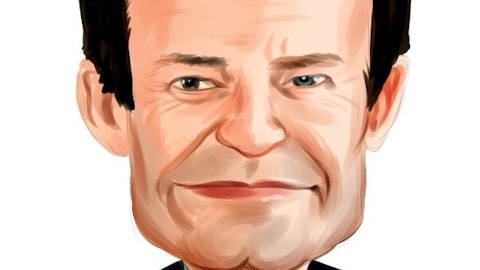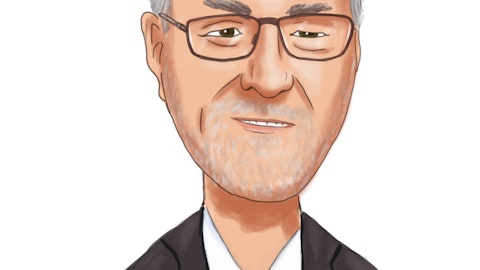Eric Colson: Yes. The retail democratization gets down to the customization of separate accounts, the custom indexes, how do you empower the individual, that is an enormous amount of people expense, back-office expense, and quite honestly, interesting fee environment as it races to the bottom. And we look at that opportunity set, coupled with the duration of those clients and assets we’ve seen in the retail mutual world. And you look at that short duration, high expense, difficult to differentiate by investment results and felt that we’re better suited to be an investment organization instead of a consumer asset manager. So, our focus will be to focus on the investment talent, deliver investment strategies and to partner with those organizations that can bring democratization and that fits how we can deliver our strategies to those partners.
And we’ve, over the years, have built a very strong business in our intermediary channel. Many of those clients know how to package these strategies well, and we’re learning more and more how to partner those. And we’ve seen strong growth in the U.S. and outside the U.S. with these partners. And our mindset will be to focus our sales efforts with partners, so that we participate in that retail democratization as an investment firm.
Bill Katz: Thank you.
Operator: The next question comes from Daniel Fannon with Jefferies. Please go ahead.
Daniel Fannon: Thanks. Just following up on the EMsights opportunity, you talked about institutional interest. Is this different than what you’ve seen with other kind of teams they’ve come on board in terms of the ramp? The track record, maybe not as important here given their legacy. And I know it’s hard to predict, but when you think about Credit in 2023 and that opportunity is more, is the dollar amounts coming in, you think more in these strategies or in the existing strategies of what would have been in the ground longer?
Eric Colson: Yes. Hi, Daniel. The record is still very important. Having that proven track record of success is always an important history and something to point to. The difference’s really been, if you look back to some of our other teams where the strategy fit very well in the intermediary or financial adviser, broker dealer, it went into the pooled vehicle and the individual is probably a more well-known person or team in that space. The assets there can come a little bit quicker than a more complex strategy that tends to be more institutional in nature. And so, first and foremost, the institutional sales cycle is longer. You have gatekeepers, you have consultants, and then you have to marry that up with quarterly investment committee meetings to go through that cycle.
So, the onboarding of assets take longer than what we’ve seen with some of the more recent strategies behind EMsights. Secondly, the setup and the account setup for emerging markets with regards to custodians and countries to open up to take advantage of the broader array that the Emerging Market Debt and Global Unconstrained strategies offer also takes time. So, while we have sophisticated clients that have gone through with the cycle, there’s still a long setup period to open up some of these accounts and finish up the investment management agreements. So, the real difference is the complications around the account setup, coupled with the institutional marketplace. From what we can see, we are in a very strong position with numerous clients and prospects, doing their due diligence and moving down the tracks with us to hopefully provide some growth to the team in 2023 and beyond.
Daniel Fannon: Got it. That’s helpful. Thank you. And then, C.J., just a follow-up on expenses. The flat year-over-year, that’s inclusive of the onetime charge? I think you said it was in the fourth quarter. And then, I guess, just other kind of cost cutting or cost containment measures that you are contemplating or not as you think about the guidance that you just gave and what might be incorporated within that for this year?
C.J. Daley: Yes. Thanks, Dan. So, the guidance, obviously, first and foremost, given our variable expense structure, the change in revenues is going to drive overall expenses as it has in the past. But on the fixed expense side, we’re really guiding to about 5% increase over 2022, which would include that $1 million charge. The majority of it is going to come in our fixed compensation costs. We’re still absorbing the full impact of the hires in the prior year. And then, we have a few additional roles in 2023, as Eric mentioned, skewed towards investments and distributions. Tech spend is going to go up probably mid-single digits. We’ve added some systems in 2022, which now the full cost of those systems, primarily related to fixed income kick in.
And then, T&E continues to return to sort of pre-COVID levels, and we expect that to be fully back to what we would have expected prior to COVID in 2023. So, overall, you’ve got about 5% mid-single-digit expected increase in fixed costs and then variable costs will be what they’d be based on revenue levels.
Daniel Fannon: Thank you.
Operator: The next question comes from Michael Brown with KBW. Please go ahead.
Michael Brown: Okay. Great. You guys talked a little bit about some of the seed investments in 2022. And that was a key focal point for you guys in 2022. Should we expect a similar level of growth in 2023, and any other change to your capital allocation approach relative to 2022?





